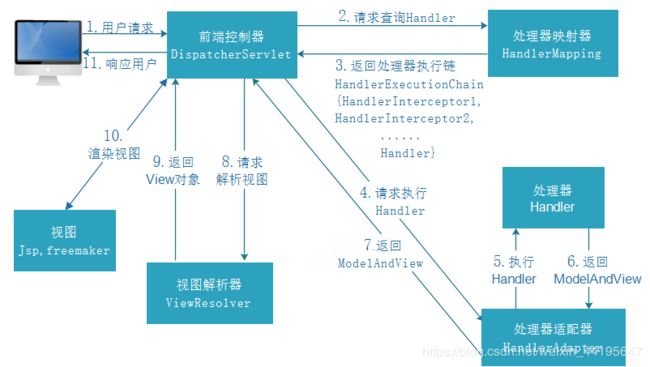SpringMVC架构模拟
这次来学习一下SpringMVC的源码.
对于常见的项目架构模式,比如大名鼎鼎的SSM(SpringMVC,Spring,Mybatis)框架.
- SpringMVC ->web层(Controller层)
- Spring ->service层
- mybatis ->dao层
从SpringMVC层面上讲,他的构成如下:
- Model ->数据
- View ->视图
- Controller ->业务
经过上面的分层,使得数据,视图(展示效果),业务逻辑进行分离,每一层的变化可以不影响其他层,增加程序的可维护性和可扩展性。
-
浏览器发出用户请求,处于web.xml中的dispacherServlet前端控制器进行接收,此时这个前端控制器并不处理请求.而是将用户发送的url请求转发到HandleMapping处理器映射器
-
第二步:HandlerMapping根据请求路径找到相对应的HandlerAdapter处理器适配器(处理器适配器就是那些拦截器或者是controller)
-
第三步:HandlerAdapter处理器适配器,可以处理一些功能请求,返回一个ModelAndView对象(包括模型数据/逻辑视图名)
-
第四步:ViewResolver视图解析器,先根据 ModelAndView中设置的view解析具体视图
-
第五步:然后再将Model模型中的数据渲染到View中
下面我们实际在项目中进行操作
一丶创建一个带有web.xml的maven项目
二丶首先自己写一个类继承HttpServlet类并重写它的doGet,doPost方法
package com.spring.mvc.config;
import javax.servlet.ServletException;
import javax.servlet.http.HttpServlet;
import javax.servlet.http.HttpServletRequest;
import javax.servlet.http.HttpServletResponse;
import java.io.IOException;
/**
* @Author: XiaoZhe
* @Description:
* @Date: Created in 17:39 2019/12/16
*/
public class MyDispatchServlet extends HttpServlet{
@Override
protected void doGet(HttpServletRequest req, HttpServletResponse resp) throws ServletException, IOException {
System.out.println("这是调用了doGet方法");
}
@Override
protected void doPost(HttpServletRequest req, HttpServletResponse resp) throws ServletException, IOException {
System.out.println("这是调用了doPost方法");
}
}
三丶修改web.xml文件
httpServletTest
com.spring.mvc.servlet.MyDispatchServlet
httpServletTest
/*
四丶 启动项目,在地址栏输入项目地址并回车
可以看到控制台打印输出了我们定义的话
这是调用了doGet方法
这是调用了doGet方法
五丶创建几个注解@Controller,@RequestMapping
用过SpringMVC框架的人都知道在类上打了@Controller注解的才能被认作是一个Controller,而打了@RequestMapping才能被请求映射。
@MyController
package com.spring.mvc.annotation;
import java.lang.annotation.ElementType;
import java.lang.annotation.Retention;
import java.lang.annotation.RetentionPolicy;
import java.lang.annotation.Target;
/**
* @Author: ZhengZhe
* @Description: 作用于class上的功能类似于Spring的@Controller注解
* @Date: Created in 10:34 2019/12/17
*/
@Target(ElementType.TYPE)//标识此注解只能作用在类上面
@Retention(RetentionPolicy.RUNTIME)//标识此注解一直存活,可被反射获取
public @interface MyController {
}
@MyRequestMapping
package com.spring.mvc.annotation;
import java.lang.annotation.ElementType;
import java.lang.annotation.Retention;
import java.lang.annotation.RetentionPolicy;
import java.lang.annotation.Target;
/**
* @Author: ZhengZhe
* @Description: 作用于class或者method上的功能类似于Spring的@RequestMapping注解
* @Date: Created in 10:38 2019/12/17
*/
@Target({ElementType.TYPE,ElementType.METHOD})//标识此注解只能作用在类或者方法上面
@Retention(RetentionPolicy.RUNTIME)//标识此注解一直存活,可被反射获取
public @interface MyRequestMapping {
String value();//用来存储对应的url , 网络请求路径
}
六丶DispatchServlet
DispatchServlet在MVC引导着非常强大的作用,网络中的请求传到DispatchServlet中,由DispatchServlet进行截取分析并传到对应的由@Controller和@RequestMapping注解的类或方法中,使得网路请求能正确的请求到对应的资源上.
下面我们自定义一个DispatchServlet实现他所实现的功能
首先看一下源码中MVC做了什么
protected void initStrategies(ApplicationContext context) {
this.initMultipartResolver(context);
this.initLocaleResolver(context);
this.initThemeResolver(context);
this.initHandlerMappings(context);
this.initHandlerAdapters(context);
this.initHandlerExceptionResolvers(context);
this.initRequestToViewNameTranslator(context);
this.initViewResolvers(context);
this.initFlashMapManager(context);
}
从上面我们可以看到初始化方法的参数是ApplicationContext,这个是IOC的初始化容器,我之前的博客中解析过IOC的源码,不懂的可以去里面解读.
initStrategies方法的目的就是从容器中获取已经解析出来的bean资源,并获取其带有@Controller和@RequestMapping注解的bean资源.
protected void doService(HttpServletRequest request, HttpServletResponse response) throws Exception {
if (this.logger.isDebugEnabled()) {
String resumed = WebAsyncUtils.getAsyncManager(request).hasConcurrentResult() ? " resumed" : "";
this.logger.debug("DispatcherServlet with name '" + this.getServletName() + "'" + resumed + " processing " + request.getMethod() + " request for [" + getRequestUri(request) + "]");
}
Map attributesSnapshot = null;
if (WebUtils.isIncludeRequest(request)) {
attributesSnapshot = new HashMap();
Enumeration attrNames = request.getAttributeNames();
label108:
while(true) {
String attrName;
do {
if (!attrNames.hasMoreElements()) {
break label108;
}
attrName = (String)attrNames.nextElement();
} while(!this.cleanupAfterInclude && !attrName.startsWith("org.springframework.web.servlet"));
attributesSnapshot.put(attrName, request.getAttribute(attrName));
}
}
request.setAttribute(WEB_APPLICATION_CONTEXT_ATTRIBUTE, this.getWebApplicationContext());
request.setAttribute(LOCALE_RESOLVER_ATTRIBUTE, this.localeResolver);
request.setAttribute(THEME_RESOLVER_ATTRIBUTE, this.themeResolver);
request.setAttribute(THEME_SOURCE_ATTRIBUTE, this.getThemeSource());
FlashMap inputFlashMap = this.flashMapManager.retrieveAndUpdate(request, response);
if (inputFlashMap != null) {
request.setAttribute(INPUT_FLASH_MAP_ATTRIBUTE, Collections.unmodifiableMap(inputFlashMap));
}
request.setAttribute(OUTPUT_FLASH_MAP_ATTRIBUTE, new FlashMap());
request.setAttribute(FLASH_MAP_MANAGER_ATTRIBUTE, this.flashMapManager);
try {
this.doDispatch(request, response);
} finally {
if (!WebAsyncUtils.getAsyncManager(request).isConcurrentHandlingStarted() && attributesSnapshot != null) {
this.restoreAttributesAfterInclude(request, attributesSnapshot);
}
}
}
doService方法其实目的就是解析用户的请求路径,根据请求路径找到对应类和方法,使用反射调用.
七丶MyDispatchServlet(自定义前端控制器)
我们自己写代码来实现对应的init方法和Service方法的功能.
package com.spring.mvc.servlet;
import com.spring.mvc.annotation.MyController;
import com.spring.mvc.annotation.MyRequestMapping;
import javax.servlet.ServletException;
import javax.servlet.http.HttpServlet;
import javax.servlet.http.HttpServletRequest;
import javax.servlet.http.HttpServletResponse;
import java.io.File;
import java.io.IOException;
import java.lang.reflect.Method;
import java.net.URL;
import java.util.Enumeration;
import java.util.Map;
import java.util.Set;
import java.util.concurrent.ConcurrentHashMap;
import java.util.concurrent.ConcurrentMap;
/**
* @Author: ZhengZhe
* @Description:
* @Date: Created in 10:56 2019/12/17
*/
public class MyDispatchServlet extends HttpServlet{
//我们定义两个集合去存储扫描到的带有@MyController 和 @MyRequestMapping注解的类或者方法
//存放 被@MyRequestMapping注解修饰的类或者方法
private ConcurrentHashMap MyMethodsCollection = new ConcurrentHashMap();
//存放 被@MyController注解修饰的类
private ConcurrentHashMap MyControllerCollection = new ConcurrentHashMap();
@Override
protected void doGet(HttpServletRequest req, HttpServletResponse resp) throws ServletException, IOException {
MyInit(req,resp);
MyService(req,resp);
}
/**
* 作用是 : 根据配置的包名,扫描所有包含@MyController注解修饰的类和@MyRequestMapping注解修饰的类或者方法
*并将对应的 beanName放入上面定义的 集合中
* @param req
* @param resp
*/
private void MyInit(HttpServletRequest req, HttpServletResponse resp) {
//在源码中,有IOC实现了容器的扫描和初始化,MVC中只是直接拿出来,但是这个方法中我们就不通过容器去获取了
//直接扫描并且存入上面的集合中就可以了
String basePackage ="com.spring.mvc";
//根据传入的包路径,扫描包,此时只是将该包下所有的文件资源存入集合中,但是并没有筛选加了@MyController和
//@RequestMapping注解的类,即扫描所有.class字节码对象并保存起来
ConcurrentHashMap> scannerClass = scannerClass(basePackage);
//下面直接进行筛选@MyController和@RequestMapping注解的类
Set>> entrySet = scannerClass.entrySet();
for (Map.Entry> entry : entrySet) {
//获取key : 类名称
String className = entry.getKey();
//获取value : 对应的.class字节码对象
Class clazz = entry.getValue();
//定义MyRequestMapping的url
String classUrl = "";
try {
//该类是否标记了MyController注解
if (clazz.isAnnotationPresent(MyController.class)){
//该类是否标记了MyRequestMapping注解
if (clazz.isAnnotationPresent(MyRequestMapping.class)){
//如果该类被MyRequestMapping注解所标识,获取其属性url值
MyRequestMapping requestMapping = clazz.getAnnotation(MyRequestMapping.class);
classUrl = requestMapping.value();
}
//将被标识了MyController注解的类存入集合中
MyControllerCollection.put("className",clazz.newInstance());
//判断该类中的方法是否标识了@MyRequestMapping注解,如果标识了存入MyMethodsCollection集合中
//获取该类下的方法
Method[] methods = clazz.getMethods();//获取该类中的方法数组
//遍历该数组
for (Method method : methods) {
//判断是否被@MyRequestMapping注解标识
if (method.isAnnotationPresent(MyRequestMapping.class)){
//已被@MyRequestMapping注解标识
//获取其url
MyRequestMapping myRequestMapping = method.getAnnotation(MyRequestMapping.class);
//获取method上的url
String methodUrl = myRequestMapping.value();
//拼接两端MyController和method的url
MyMethodsCollection.put(classUrl+methodUrl,method);
}
}
}
} catch (Exception e) {
e.printStackTrace();
}
}
}
//根据传入的包路径,进行bean资源的获取,一般可以在xml中设置包路径.但是我们直接给出即可(简单)
private static ConcurrentHashMap> scannerClass(String basePackage) {
ConcurrentHashMap> result = new ConcurrentHashMap<>();
//把com.spring.mvc 换成com/spring/mvc再类加载器读取文件
String basePath = basePackage.replaceAll("\\.", "/");
try {
//得到com/spring/mvc的绝对地址 /D:xxxxx/com/spring/mvc
String rootPath = MyDispatchServlet.class.getClassLoader().getResource(basePath).getPath();
//只留com/ming/mvc 目的为了后续拼接成一个全限定名
if (rootPath != null) {
rootPath = rootPath.substring(rootPath.indexOf(basePath));
}
Enumeration enumeration = MyDispatchServlet.class.getClassLoader().getResources(basePath);
while (enumeration.hasMoreElements()) {
URL url = enumeration.nextElement();
if (url.getProtocol().equals("file")) {//如果是个文件
File file = new File(url.getPath().substring(1));
scannerFile(file, rootPath, result);
}
}
} catch (IOException e) {
e.printStackTrace();
}
return result;
}
//递归扫描文件
private static void scannerFile(File folder, String rootPath, ConcurrentHashMap> classes) {
try {
File[] files = folder.listFiles();
for (int i = 0; files != null && i < files.length; i++) {
File file = files[i];
if (file.isDirectory()) {
scannerFile(file, rootPath + file.getName() + "/", classes);
} else {
if (file.getName().endsWith(".class")) {
String className = (rootPath + file.getName()).replaceAll("/", ".");
className = className.substring(0, className.indexOf(".class"));//去掉扩展名得到全限定名
//Map容器存储全限定名和Class
classes.put(className, Class.forName(className));
}
}
}
} catch (Exception e) {
e.printStackTrace();
}
}
/**
* 作用是 : 解析用户的请求路径,,根据请求路径找到对应的类和方法,并使用反射调用其方法
* @param req
* @param resp
*/
private void MyService(HttpServletRequest req, HttpServletResponse resp) {
//在MyInit中我们已将被@MyController和@MyRequestMapping注解标识的类或者方法存入对应的集合中了;
//下面我们需要将网络请求中的url和我们容器中初始化好的url进行匹配,如果匹配成功,那么直接执行此方法
//返回除去host(域名或者ip)部分的路径(包含)
String requestURI = req.getRequestURI();//类似test/test
//返回工程名部分,如果工程映射为/,此处返回则为空 (工程名即项目名)
String contextPath = req.getContextPath();//类似test
//获取实际除 ip,端口,项目名外的请求路径
//如web.xml中的servlet拦截路径设置的为/* 采用下面的方法,如果采用的是/*.do或者/*.action类似的后缀,需要把后面的也去掉
String requestMappingPath = requestURI.substring(contextPath.length());
//通过截取到的实际的请求url为key获取对应的方法
Method method = MyMethodsCollection.get(requestMappingPath);
try {
if (method == null){
//此时就是大名鼎鼎的404 了~
//直接返回404
resp.sendError(404);
return;
}
//存在,那么直接执行
//获取方法所对应的的class字节码文件
Class declaringClass = method.getDeclaringClass();
//下面按照源码来说还需要去判断是否是单例等操作,我们直接省去
method.invoke(declaringClass.newInstance());
} catch (Exception e) {
e.printStackTrace();
}
}
@Override
protected void doPost(HttpServletRequest req, HttpServletResponse resp) throws ServletException, IOException {
System.out.println("这是调用了doPost方法");
}
}
八丶创建ControllerTest测试类
package com.spring.mvc.controller;
import com.spring.mvc.annotation.MyController;
import com.spring.mvc.annotation.MyRequestMapping;
import javax.servlet.http.HttpServlet;
import javax.servlet.http.HttpServletResponse;
import java.io.IOException;
import java.io.PrintWriter;
import java.util.HashMap;
import java.util.Map;
/**
* @Author: ZhengZhe
* @Description:
* @Date: Created in 15:07 2019/12/17
*/
@MyController
@MyRequestMapping("/hello")
public class ControllerTest {
@MyRequestMapping("/world")
public void helloworld(){
System.out.println("自定义MVC测试成功~ ,现在时间是"+System.currentTimeMillis());
}
}
查看控制台输出:
信息: At least one JAR was scanned for TLDs yet contained no TLDs. Enable debug logging for this logger for a complete list of JARs that were scanned but no TLDs were found in them. Skipping unneeded JARs during scanning can improve startup time and JSP compilation time.
[2019-12-17 03:33:26,276] Artifact mvc:war exploded: Artifact is deployed successfully
[2019-12-17 03:33:26,276] Artifact mvc:war exploded: Deploy took 565 milliseconds
自定义MVC测试成功~ ,现在时间是1576568012163
